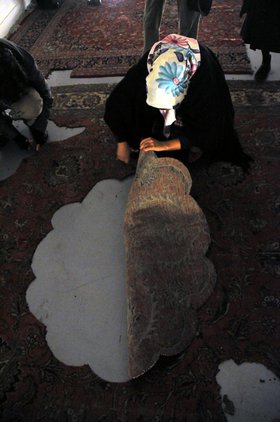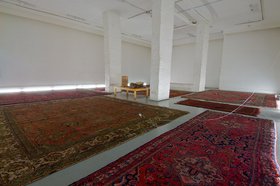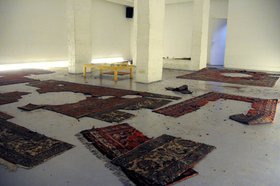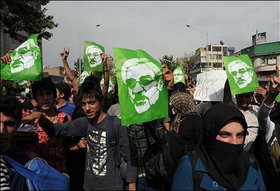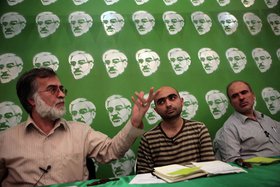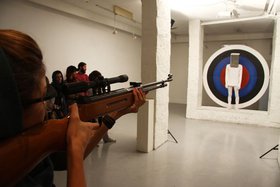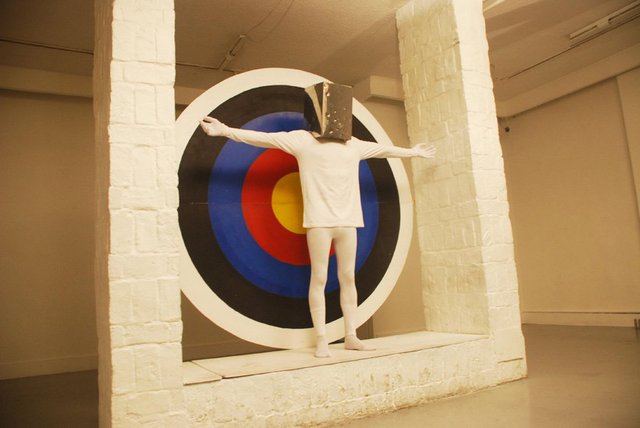Essays
Articulating Dissensus
Contemporary Artistic Practice in Iran at a Revolutionary Moment
The relationship between art and politics has always been a topic for heated intellectual debate. In this context, it is arguable that a new political order requires a new artistic language that can give visual form to the new set of ideals by which new ruling elites claim to be guided. The complexities of both artistic production and social transformation are exposed in this paper through the scrutiny of art created in a situation of political urgency. This argument has stimulated theoretical discourse since Plato introduced the concept of the ethical regime of images in his Republic.
My hypothesis is that the importance of the social role of artistic practice has usually occurred during periods of political urgency, such as revolution.[1] There are numerous examples of this. The Russian Bolshevik Revolution of 1917 is probably the most striking; and of course, the revolution of 1979 in Iran shaped a whole new artistic language.
In such circumstances, political or religious powers have typically made very obvious interventions by issuing directives and guidelines on how artistic practice 'should' be transformed in order to comply with their new ideologies.[2] In this paper, I refer to a 1934 speech by Anatoliy Lunacharsky at the Congress of Soviet Writers in which he defined Social Realism.
Specifically, this paper is focused on how the theoretical debate around the complexities of interaction between art and politics unfolds within the context of contemporary Iranian society. Iran is a unique example for this kind of analysis, firstly because of its geo-politics, which situate the country at the crossroads between the West and the Middle East, meaning that the assimilation of Western influences into this traditional Islamic society has deep historical roots;[3] but also because of the ideology of the Islamic Republic, which can be described as an interpretation of Shi'a Islam through Structural Marxism, by which it has incorporated the concept of political struggle into religious dogma.[4] This collision and intertwining of two very different ideologies and theoretical mindsets provides a site in which to question the relevance and interpretation of a theory drawn from a different socio-political context; in the case of this paper, Jacques Rancière's writings and how they might apply to the situation in Iran. There is a certain historical continuity of thought that gives grounds for this use of a western theoretical structure for an analysis of the events of 2009.
The Green Movement's post-election protests lasted three months all around the country, and had a huge impact not only on Iran but also on the rest of the region, as we witnessed in the unfolding of the 'Arab Spring'.
This is a brief overview of the events that led to the uprising. The official results of the presidential elections held on 12 June 2009 officially named Mahmoud Ahmadinedjad, a conservative candidate, the winner, with approximately 70 percent of the vote. These results, and the rushed manner in which they were announced, created an outrage; thousands of people went on the streets all over Iran, and the demonstrations continued for several months. The protestors claimed that the election results were rigged, and therefore they refused to accept Mahmoud Ahmadinejad as the elected president. The opposition, led by Hossein Mousavi and Mehdi Karroubi, came together, and became known as the Green Movement. Throughout the country, people's everyday lives – whether they were involved in the protests or not – were put on hold; it was clearly a moment of crystallized revolutionary euphoria, or, as Zizek puts it, a 'moment of suspension when the bright future seems to have already happened.'[5]
This euphoric moment ended unhappily. The regime used violent means to suppress the unrest; even so, protest continues to the present day, with activists continuing to be arrested and ordinary citizens battling ideological restrictions, from Internet censorship to the elimination of contemporary philosophical theory from university curriculums. But I would like to bring the discussion back to the question of the relationship between art and politics.
Dissensual Subjectivation and Artistic Practice
In order to unfold the meaning of the political subject and examine the relationship between the political and the artistic within a theoretical context, Jacques Rancière's writings provide arguably the most relevant and timely grounding for debate. Rancière introduced the concept of 'dissensual subjectivation', initially in relation to the genesis of a political action, in his Ten Theses on Politics; it refers to the moment when a generalized feeling of discontent in society coalesces into a conceptual subject, which then flows into shaping an event of oppositional action. He defines the process thus: 'Dissensus is not a confrontation between interests or opinions. It is the demonstration (manifestation) of a gap in the sensible itself.' A key focus of this argument is on how this political (or dissensual) subjectivation is interpreted in the artworks used here as a case study, and what impact this particular subjectivity has on artistic practice. In other words, the essence of my research topic is a study of the long-standing concerns of art and activism, and the cause-effect dynamic between the two. What also interests me is how political subjectivity affects the way that art is produced.
The rhetoric on the relationship between object and subject in an artwork is an ongoing debate, descending from Kantian-Hegelian dialectic. In his essay 'Subject-Object', Adorno defines it as an intertwined interaction of equal components: 'the reciprocity of subject and object in the work, which cannot be that of identity, maintains a precarious balance. It must be the artwork's ineluctable ambition to achieve balance without ever being quite able to do so'.[6] Here, Adorno is writing of the 'perfect', 'ideal' artwork that carries within itself this formal balance between materiality and content. If the production of an object, image and, finally, artwork is a relatively straightforward process, at least on the surface, the question of subjectivation and its translation into an artwork remains open. At the same time, dissensual subjectivity, formed by a political process through objectivation in an artwork, becomes its aesthetic quality. This raises an interesting aspect of the subject-object interrelation: does the subject matter influence the materiality of an object, or, more precisely, does the subject dictate the choice of medium – or vice versa?
In the Iranian context, the moment that could be seen as the incorporation of the meaning of dissensual subjectivation into the political context occurred most recently in 2009, with the emergence of the political opposition and the pouring of the people onto the streets. This transformation didn't happen overnight, and the process of formation of this social situation went hand in hand with the new artistic practices coming to prominence, such as performance, happenings and participatory works. Here, I focus on three works: Shahab Fotouhi's (in collaboration with graphic artist Farhad Fozouni) By the Horses Who Run Panting (2009); Neda Razavipour's Self-service (2009); and Amir Mobed's (as Chris Burden) Come Caress Me (2010). What connects these works is their relation to the actual protests on the timeline of the revolution. Shahab Fotouhi's and Neda Razavipour's works were created just before the elections and in the immediate aftermath, respectively, whereas Amir Mobed's performance happened one year after the events of the Green Movement had finished.
The project by Shahab Fotouhi (b. 1980), By the Horses Who Run Panting, 2009, was a collaboration with a graphic designer, Farhad Fouzuni, who made the poster, and Azad Art Gallery, which gave the space for the exhibition. In June 2009, prior to the presidential elections, Fotouhi transformed the gallery into a centre for opposition campaigners. Azad Gallery officially claimed that it was temporarily closed down because of the law that prevented art institutions from intervening in political affairs. However, there was another piece of legislation that allowed citizens to use their property for political campaigns. Therefore, the campaigners were still able to use the building. The gallery/campaign office became a space of intense political debate for the duration of the show. As we can see from the images, the poster (a portrait of Hossein Mousavi) went viral, and was disseminated across the streets of Tehran.
To a large extent, this work exposed two major phenomena: the deeply intertwined relationship between art and politics in Iran, and the process that Rancière called the gap, the sensible itself or the rupture in the symbolic order. One can argue that, by incorporating this paradox in Iranian legislation into the artwork, Fotouhi created that sensory form of strangeness that Rancière mentioned as being one of the distinct characteristics of critical art. Fotouhi's work is also interesting from a formal point of view. He deployed multiple conceptual approaches: from appropriation, to happening/performance, to participatory practices. It was his desire to publicize his political preoccupations that triggered his search for a new form of expression. Even though Rancière himself was critical of art deploying this type of subversion of the social order, in this particular work the way that Fotouhi reconfigured the fabric of the sensory experience of a gallery goer was successful in developing awareness of the underlying reasons for this so called 'strangeness'.
One can argue that, despite the failure of the demonstration to produce a dramatic change in the Iranian political system and its ideological direction, the Green Movement still managed a major achievement: namely the re-configuration of the perception of the political texture of society, and therefore a re-configuration of the partitions of the sensible within the Iranian political system.
Nonetheless, the failure of the Green Movement in 2009 had a devastating effect on intellectual and artistic communities in Iran. The whole notion of the power of artistic practice as a vehicle of social change has been questioned ever since; as a result, a number of reflective artworks and exhibitions have been produced in an attempt to reassess the events, to look in depth at why it became a fiasco, and to mourn the victims.
The installation/happening by Neda Razavipour (b. 1969 Tehran, Iran), Self-service (2009), dealt with the notion of violence and its socio-political importance. The gallery space was covered with traditional Persian rugs, and the visitors were asked to cut out a piece from any of the rugs, which they could then take with them in a paper bag that had a quote from Plato's Republic printed on it in English and Farsi:
The story is that Leontius, the son of Aglaion, coming up one day from the Piraeus, under the north wall on the outside, observed some dead bodies lying on the ground at the place of execution. He felt a desire to see them, and also a dread and abhorrence of them; for a time he struggled and covered his eyes, but at length the desire got the better of him; and forcing them open, he ran up to the dead bodies, saying 'Look, ye wretches, take your fill of the fair sight...[7]
The rug has a symbolic meaning in Iranian culture: it is a metaphor for national identity, as well as an allegory of the domestic environment and the security it provides. Razavipour pushed the viewer to perform an act of brutality and destruction on an object that is, to large extent, the essence of Iranian being. Her reference to Plato's Republic gave the work a further, deeper layer of meaning. The Republic is arguably the founding text of Western political philosophy; it sets out the doctrine of a democratic society and has been the main point of reference for many thinkers, including Rancière, in their political analyses. With this quote, Razavipour drew attention to the very origins of democracy, which was now struggling in the face of the justifiable terror of revolution. This idea of the terror that brings peace is the paradox that Razavipour questioned in her work. And this is where the rupture of the sensible occurs for her.
It is also relevant to mention here the problem of the mediation of dissensual subjectivity through an objective artwork. Or, more importantly, what sort of objective solutions this subjectivity introduces. On the matter of the revelation of society in its difference to itself and in the creation of the gap in the body of the sensible, or in relation to dissensual subjectivation, Razavipour's work deserves further analysis and interpretation. I look at it in more detail below. But when we talk about re-assigning the events and outcomes of the protests, one work has particular importance: the performance Come Caress Me, by Amir Mobed (b. 1974), shown at the Azad gallery in Tehran on 10 September 2010. It was inspired by Chris Burden's work Shoot (1971), depicting a moment when his assistant (accidently) shot the artist in the left arm.
(In 1971, in the context of the war in Vietnam, Burden's gesture was interpreted as critical denunciation of the violence conducted by US troops against local civilians. Burden himself claimed that the actual shooting was an accident, that no damage was intended, and that his main artistic concern was to attract attention to the notion of personal danger in artistic practice.[8])
However, Mobed's re-enactment of the performance was much more extreme and provocative. He asked the gallery visitors to take a pneumatic rifle and intentionally shoot him from three suggested firing lines drawn on the floor, labelled: Hate you, Like you and Love you, respectively, where hatred was the furthest from and love was the closest to the target.
The performance was expressly conceived to create a certain degree of controversy, starting with the name on the invitation: Chris Burden, instead of Amir Mobed. On the one hand, it was an homage to the American artist whose work was re-interpreted. At the same time, by putting Burden's name on the invitation, Mobed attempted not only to conceal his own identity, but also to play with an aura of mystery and deception that often surrounds performances.[9] Yet, despite such a clear inter-textual reference, Mobed's work raises a very different set of issues. It was not about the danger of being an artist, unlike Burden's work; this time it was about the complexity and multidimensionality of violence in politics. The work was performed a year after the Green Movement protests, which means there had been time to detach from, reflect on and re-assess what happened. This consequently placed the work within a wider ontological context.
Nonetheless, it does not tone down the work's acute political message. Reference to human emotions reflects a certain degree of sentimentality, but it also puts a spotlight on a whole new aspect – of human emotions – as a motivator of radical action. One of the outcomes of the opposition's protests in 2009 was the state of shock that society experienced in the face of the extreme violence perpetrated by the regime's official forces. Following the events, much intellectual critique was focused on this unprecedented and unexpected violence coming from the religious government. In his work, Mobed reflected the critical voices back at their speakers and pointed out that 'society' – in this case the same intellectuals and people, close to artistic circles, who participate in the performance – is itself profoundly violent, and that there is a rupture in its integrity, or, using Rancière vocabulary, in the sensible order.
The work also made one reflect on the meaning of revolutionary violence in a similar way to Razavipour's work – something largely unavoidable in a struggle against oppression. From this viewpoint, performance actually becomes critical in respect to the opposition supporters who abandoned the streets and did not fight for their ideals, but who fell back to what they saw as the core of their principles: the unacceptability of militant action. This mode of unexpected questioning in the work, and this poignant criticism not only of 'them', but also of 'us', gave it an additional, complicating and bitterly ironic dimension. This unexpected angle of critique brought into the work the element of the rupture of the sensible, or dissensus. The work, in fact, provoked a redistribution of the sensible as it pulled forward new, hidden issues that were not previously spoken about. What is also interesting in this particular work in relation to dissensual subjectivation is that it was the subjectivity of the work that was allowed to determine its formal execution of objectivation.
Conclusion
In one of his lectures, Boris Groys defined an artwork as the documentation of an artistic process, of a stream of ideas.[10] Groys pursued the notion that a representation of an object is not an object, but a work of art;[11] he went a step further by claiming that it is simply a documentation of the creative artistic process. Following this idea, an artwork can also be seen as the documentation of a political action/event. This theoretical perspective imbues artworks with a historical quality. From this standpoint, critical art might be seen as the documentation of the process of formation of dissensual subjectivation. This 'documentation' makes visible the social situation of discontent, in turn raising awareness that is essential for the framing of dissensus.
The notion of historical reassessment of political events brings up the further question of the possibility of representing terror – something that becomes an ethical question within aesthetics. In his essay 'The Ethical Turn of Aesthetics and Politics', Rancière defines terror as a trauma: 'Terror is precisely the name that trauma takes in political matters.'[12] If, according to this definition, terror is a trauma in politics, then how is it possible to deal with the burden of moral issues that make it unrepresentable in artistic terms? Rancière argues that
The unrepresentable, which is the central category of the ethical turn in aesthetic reflection, is also a category that produces an indistinction between right and fact, occupying the same place in aesthetic reflection that terror does on the political plane. The idea of the unrepresentable in fact conflates two distinct notions: impossibility and interdiction. This declaration of impossibility in fact conceals a prohibition. The prohibition, however, also conflates two things: a proscription that bears on the event and a proscription that bears on art.[13]
Faced by this ethical and theoretical dilemma, Rancière sees a solution in fictional inquiry. He argues that artistic narration places the ethical question of the unrepresentability of terror within the domain of art, where it can be dealt with through artistic agency:
To invoke an art of the unrepresentable, it is therefore necessary to pull this unrepresentable from a realm other than that of art itself. The surplus of representation inherent in the ruin of the representative order must be transformed into its opposite: a lack or an impossibility of representation. [14]
With respect to this line of thinking, Amir Mobed's performance inevitably comes to mind as an example of dealing with the ethical issues of representation through enactment and performative play. The same element of enactment is present in Neda Razavipour's work.
The direction that we should undoubtedly steer away from in this debate is one that reduces art to the ethical witnessing of unrepresentable catastrophe;[15] art should not be divorced either from its aesthetic component or from its proactive position because, according to Rancière, 'artworks can produce effect of dissensus precisely because they neither give lessons nor have any destinations.'[16]
[1] Here, the term 'revolution' is used to define activity or movement designed to effect fundamental changes in political organization and the socioeconomic situation. In this case, the directives referred to are: the decrees of the final session of the Council of Trent in 1563, including short and rather inexplicit passages concerning religious images, which were to have great impact on the development of Catholic art; and the theory of Soviet Social Realism delivered at the Congress of Soviet Writers in 1934, directly approved by, amongst others, Joseph Stalin.
[2] In this case, the directives referred to are: the decrees of the final session of the Council of Trent in 1563, including short and rather inexplicit passages concerning religious images, which were to have great impact on the development of Catholic art; and the theory of Soviet Social Realism delivered at the Congress of Soviet Writers in 1934, directly approved by, amongst others, Joseph Stalin.
[3] The influences mentioned here refer to the nineteenth century, when Persia (now known as Iran) was divided between two major empires – the British Empire in the South and the Russian Empire in the North – which, without officially colonizing the country, had considerable economic and political involvement in its local affairs. See E. Abrahamian, A History of Modern Iran (New York: Cambridge University Press, 2008).
[4] Ibid., 57-60.
[5] 'Revolution We Love You,' panel discussion, Tate Modern, 17 December 2009 http://channel.tate.org.uk/audio/64665077001.
[6] Ibid., 218-219.
[7] N. Razavipour, personal interview, Tehran, Iran, 7 February 2011.
[8] P. Schjeldah, 'Chris Burden and the Limits of Art,' The New Yorker, 14 May 2007 www.newyorker.com/arts/critics/artworld.
[9] I had an extensive conversation with Amir Mobed about his praxis in general, and in particular about Come Caress Me, and therefore my analysis of this performance is highly influenced by this conversation and my awareness of the artist's intention.
[10] B. Groys, 'Spheres of Action: Art and Politics,' panel discussion, Tate Britain, 10 December 2005 http://www.tate.org.uk/context-comment/video/spheres-of-action-art-and-politics.
[11] R. Magritte, La Trahison des Images [The Treachery of Images] or Ceci n'est pas une pipe [This is not a Pipe], 1928-1929, oil on canvas, Los-Angeles, LACMA.
[12] J. Ranciere, Dissensus, on Politics and Aesthetics (London: Continuum International Publishing Group, 2010), 187.
[13] Ibid., 195.
[14] Ibid., 197-198.
[15] Ibid., 201.
[16] Ibid., 140.

